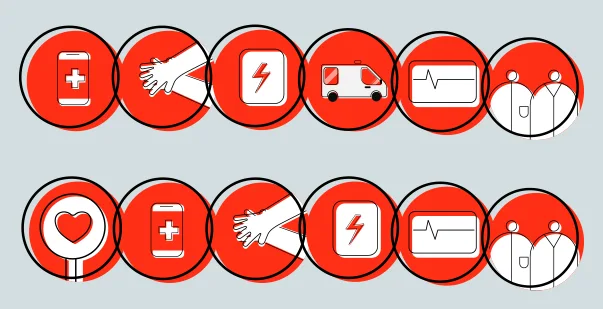Table of Content(s)
- Introduction
- What are the steps in BLS chain of survival?
- Why is the chain of survival important?
- What are the steps in the Pediatric Chain Of Survival?
- Important Considerations to keep in mind during Pediatric Emergencies
- What are the steps of basic life support?
- Conclusion
When emergencies happen, every second counts. The chain of survival is a crucial concept. It highlights the key steps that serve as important stepping stones for survival success. Whether it is a sudden cardiac arrest at home or in the public, immediate action can make all the difference.
Over 475,000 Americans die annually due to cardiac arrests, but timely assistance can positively change the numbers.
BLS Chain Of Survival involves critical steps to recognize, and provide the best possible care depending on the emergency and its severity. Each link in the chain ensures that help arrives quickly and effectively. But how do these steps work together? Let’s understand each one of these steps in detail and understand why they are so crucial in BLS (Basic Life Support) interventions.
Master BLS Now
Get BLS certified with confidence
What are the steps in BLS chain of survival?
In emergencies, the chain of survival serves as a guidebook. The important steps ensure immediate yet appropriate care and drastically reduces mortality rates.
Let’s find out in-depth, the steps in BLS chain of survival:
Immediate recognition of cardiac arrest and activation of emergency response
Early recognition and calling 911 or emergency services starts the process of life-saving interventions.
Early CPR with high-quality chest compressions
Starting chest compressions right away helps maintain blood flow to vital organs. This doubles up the survival rates.
Rapid defibrillation
Using an Automated External Defibrillator (AED) to restore a normal heart rhythm as soon as possible can significantly improve outcomes.
Effective advanced life support
Once emergency personnel arrive, they continue advanced care. This includes medication and further resuscitation efforts.
Integrated post-cardiac arrest care
After resuscitation, ongoing care and monitoring is essential. This prevents further complications and ensures recovery.
Read More: A Simple Guide to Becoming a BLS Instructor
Why is the Chain of Survival Important?
The chain of survival is not just a guide. It is a proven strategy that can mean the difference between life and death. Every minute that passes without CPR and AED intervention, the chances of survival decreases by 7-10%.
These are the reasons why the chain of survival is important:
- Promotes fast action
Immediate recognition and response minimize the delay in providing life-saving care. - Improves outcomes with early CPR
High-quality chest compressions keep blood flowing to the brain and heart, preventing further damage while waiting for advanced care. - Boosts survival rates through rapid defibrillation
Defibrillation within minutes of cardiac arrest significantly increases the likelihood of restoring a normal heart rhythm. - Ensures comprehensive care
The chain doesn’t end with CPR and defibrillation—post-cardiac arrest care ensures patients get the critical follow-up treatment they need. - Empowers bystanders to act
Understanding the Chain of Survival equips people with the confidence to intervene in emergencies, potentially saving more lives.
What are the steps in the Pediatric Chain Of Survival?
When it comes to pediatric emergencies, the Chain of Survival is slightly different from that of adults. Here are the steps in pediatric chain of survival:
- Prevention of cardiac arrest
In children, preventing respiratory issues or other underlying causes of cardiac arrest is the first crucial step. Proper supervision and early management of illnesses play a vital role in prevention. - Early high-quality CPR
If cardiac arrest occurs, starting CPR immediately is essential to maintain blood flow and oxygen delivery to vital organs. - Rapid activation of emergency medical services (EMS)
Calling for professional help as soon as possible ensures advanced care will arrive quickly. This improves the chances of survival. - Effective advanced life support (ALS)
Once medical professionals arrive, they provide advanced life-saving measures. This includes medication, airway management, and further resuscitation efforts. - Post-cardiac arrest care
After successful resuscitation, comprehensive care in a medical facility is essential to address any underlying conditions and prevent further complications.
Read More: What Is the Effect of Excessive Ventilation?
Important Considerations to Keep in mind During Pediatric Emergencies
Pediatric emergencies can be challenging due to the unique needs and physiology of children. Unlike adults, children’s responses to illness or injury can escalate rapidly. This is why you must act immediately. Here are things to keep in mind during pediatric emergencies:
- Recognize early warning signs
Children often show subtle signs of distress before their condition deteriorates. Look for changes in breathing, skin color, or consciousness. - Age-appropriate CPR and First Aid
Pediatric CPR involves different techniques than adult CPR. Compressions and rescue breaths vary. Knowing these differences is key. - Airway management is crucial
Respiratory issues are a common cause of emergencies in children. Ensuring a clear airway is often the first step in saving a child’s life. - Stay calm and reassuring
Children can become frightened easily during emergencies. Keeping calm helps them feel secure and can prevent panic. - Involve caregivers
Involving parents or guardians during emergency care can provide valuable information about the child’s health and emotional comfort.
What are the steps of Basic Life Support?
Below are the steps of Basic Life Support. Follow to proceed with the intervention in case of cardiac arrests, strokes or other respiratory emergencies.
- Scene Assessment
Ensure the area is safe for both the rescuer and the victim before approaching and assessing the individual’s condition. - Emergency response
Call for help immediately if the person is unresponsive, and send for an Automated External Defibrillator (AED). - Start CPR
Begin with chest compressions at a rate of 100-120 per minute. This helps the chest recoil. Follow by rescue breaths if possible. - Defibrillation
Use an AED as soon as it’s available to check for a shockable rhythm and deliver a shock if needed. - Continue CPR
Alternate between compressions and breaths, continuing to follow AED prompts, and provide care until emergency services take over.
Conclusion
Understanding BLS chain of survival is important for responding effectively. Each step, from recognizing the problem, to providing appropriate solutions ensures advanced care, improves the survival rates. Act quickly and follow the steps as mentioned above to improve recovery chances. Learn the chain of survival well to be confident during a crisis.







